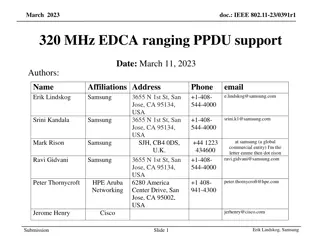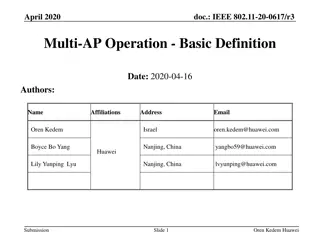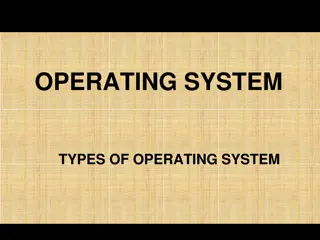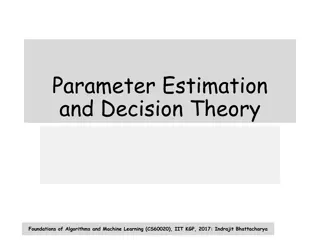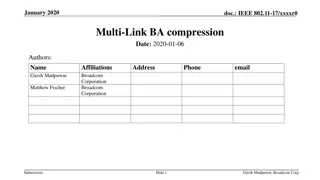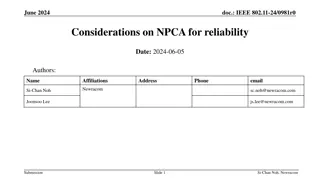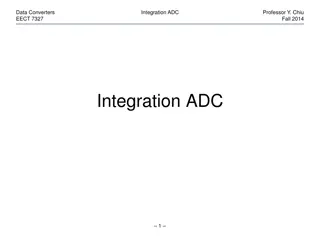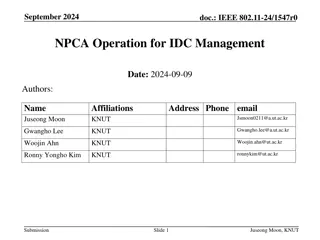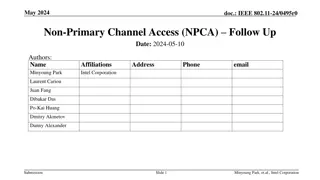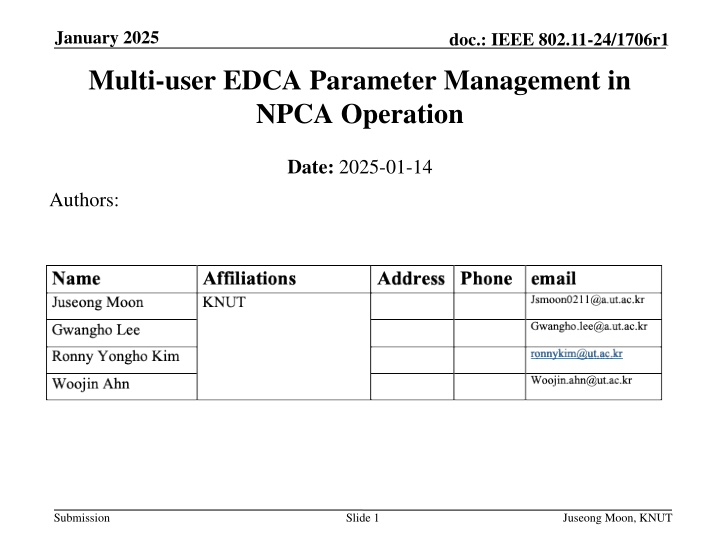
IEEE 802.11-24/1706r1 Multi-user EDCA Parameter Management
Explore the management of multi-user EDCA parameters in NPDA operations within IEEE 802.11-24/1706r1 in January 2025. Details include MU EDCA timer operations, parameter application in NCPA primary channels, and discussions on MU EDCA timer management.
Download Presentation

Please find below an Image/Link to download the presentation.
The content on the website is provided AS IS for your information and personal use only. It may not be sold, licensed, or shared on other websites without obtaining consent from the author. If you encounter any issues during the download, it is possible that the publisher has removed the file from their server.
You are allowed to download the files provided on this website for personal or commercial use, subject to the condition that they are used lawfully. All files are the property of their respective owners.
The content on the website is provided AS IS for your information and personal use only. It may not be sold, licensed, or shared on other websites without obtaining consent from the author.
E N D
Presentation Transcript
January 2025 doc.: IEEE 802.11-24/1706r1 Multi-user EDCA Parameter Management in NPCA Operation Date: 2025-01-14 Authors: Submission Slide 1 Juseong Moon, KNUT
January 2025 doc.: IEEE 802.11-24/1706r1 Abstract TGbn agreed NPCA operation for enhancing medium efficiency[1]. TGbn defines a mode of operation that enables a STA to access the secondary channel while the primary channel is known to be busy due to OBSS traffic or other TBD conditions. The mode of operation shall not assume that the STA is capable to detect or decode a frame and obtain NAV information of the secondary channel concurrently with the primary channel. A BSS shall only have a single NPCA primary channel (name TBD) on which the STA contends while the primary channel of the BSS is known to be busy due to OBSS traffic or other TBD conditions. There is the contribution[2] that discussed about EDCA Parameters on Primary and NPCA Primary Channel The contribution suggests that same EDCA Parameter set shall be applied for both Primary and NPCA Primary Channel However, there are some details which must be discussed for NPCA operation. MU EDCA Timer (EDCA state variable) management in NPCA has not been discussed. In this contribution, MU EDCA Timer management for NPCA is discussed Submission Slide 2 Juseong Moon, KNUT
January 2025 doc.: IEEE 802.11-24/1706r1 Background: MU EDCA Timer In HE, MU EDCA Timer operation was adopted for triggered uplink operation MU EDCA Timer operation can lower the channel congestion and guarantee the fairness when triggered uplink operation is used. When STAs transmitted TB PPDU based on an AP s trigger frame, they must set MU EDCA Timer and use MU EDCA Parameters (CWmin, CWmax, AIFSN) during the MU EDCA Timer In the current NPCA PDT[3], MU EDCA Parameter usage on the NPCA Primary channel has been adopted When an NPCA STA switches to the NPCA primary channel for NPCA operation, then the following rules apply: c) The STA shall use the same EDCA parameter set, MU EDCA parameter set, and EPCS EDCA parameter set values for operation on the NPCA primary channel as it uses on the BSS primary channel. However, this text does not cover the case how to manage MU EDCA timer(s) on the Primary channel and the NPCA Primary channel MU EDCA Timer is not the MU EDCA parameter set, but it is state variable of EDCAF(s) which can be set from the MU EDCA parameter set. Submission Slide 3 Juseong Moon, KNUT
January 2025 doc.: IEEE 802.11-24/1706r1 Unclear MU EDCA Timer Management in NPCA When MU operation is performed in an NPCA primary channel, MU EDCA parameter shall be applied to non-AP STAs which have participated in MU transmission MU EDCA Timer[AC] state variable for NPCA Primary channel will be set from MU EDCA Parameter set element However, there are no sufficient discussions that how MU EDCA Timer[AC] State variable to be applied for Primary channel This contribution discusses two options for setting MU EDCA Timer for primary channel Submission Slide 4 Juseong Moon, KNUT
January 2025 doc.: IEEE 802.11-24/1706r1 Option 1: Common MU EDCA Timer MU EDCA Timer can be inherited from NPCA primary channel to primary channel and vice versa Each non-AP STA can have common MU EDCA timer on Primary and NPCA Primary channel Pros Fairness can be maintained in Primary channel Cons If unsolicited UL is not allowed for NPCA Primary channel, triggered STAs in the NPCA Primary channel s channel access will be deferred due to MU EDCA Parameter in the Primary channel Submission Slide 5 Juseong Moon, KNUT
January 2025 doc.: IEEE 802.11-24/1706r1 Option 2: Independent MU EDCA Timer Primary channel and NPCA Primary channel have independent MU EDCA Timers Each non-AP STA can maintain two MU EDCA timers on Primary and NPCA Primary channel. And these timers are independent. Pros Channel access of STAs that have transmitted in the NPCA Primary channel will not be deferred due to MU EDCA Parameter in the Primary channel Cons Fairness can be degraded in the Primary channel due to aggressive EDCA Parameters in the BSS Primary Channel. Submission Slide 6 Juseong Moon, KNUT
January 2025 doc.: IEEE 802.11-24/1706r1 Preferred Option of MU EDCA Timer Management in NPCA This contribution prefer the option 1 The purpose of MU EDCA Timer is to guarantee the fairness and lower the channel congestion in triggered uplink transmission The STAs which transmitted TB PPDU should be restricted their channel access during MU EDCA Timer in the primary channel and NPCA primary channel identically. One MU EDCA Timer is needed for MU EDCA Parameter management The option 1: Common MU EDCA Timer, can guarantee Better fairness Enhanced medium control by AP Submission Slide 7 Juseong Moon, KNUT
January 2025 doc.: IEEE 802.11-24/1706r1 Summary This submission proposed MU EDCA parameter management methods in NPCA operation Discussions on MU EDCA Timer state variable management in NPCA operation was not sufficient. This contribution discussed about MU EDCA Timer state variable management in NPCA operation. The option 1 is common MU EDCA Timer method The option 2 is independent MU EDCA Timer method The option 1 is preferred for correct MU EDCA Timer operation in NPCA Submission Slide 8 Juseong Moon, KNUT
January 2025 doc.: IEEE 802.11-24/1706r1 Straw Polls Straw Poll #1: Which of the MU EDCA Timer state variable management methods do you support? (from document 24/1706r1) Option 1: Common MU EDCA Timer for Primary and NPCA Primary Channel Option 2: Independent MU EDCA Timer for Primary and NPCA Primary Channel O1: / O2: / Abs: Submission Slide 9 Juseong Moon, KNUT
January 2025 doc.: IEEE 802.11-24/1706r1 Straw Polls Straw Poll #2: Do you agree to modify the NPCA PDT as the following? The following modification is related to the option 1 from document 24/1706r1 When an NPCA STA switches to the NPCA primary channel for NPCA operation, then the following rules apply: c) The STA shall use the same EDCA parameter set, MU EDCA parameter set, and EPCS EDCA parameter set values for operation on the NPCA primary channel as it uses on the BSS primary channel. NOTE The baseline EDCA procedure is followed on the BSS primary channel. The values of CW_NPCA[AC] and BO_NPCA[AC] are discarded by the NPCA STA when it switches back to the BSS primary channel. xx) If the STA is non-AP STA, the STA shall use the same MUEDCATimer[AC] timer on the NPCA primary channel as the BSS primary channel. O1: / O2: / Abs: Submission Slide 10 Juseong Moon, KNUT
January 2025 doc.: IEEE 802.11-24/1706r1 Straw Polls Straw Poll #3: Do you agree to modify the NPCA PDT as the following? The following modification is related to the option 1 from document 24/1706r1 When an NPCA STA switches to the NPCA primary channel for NPCA operation, then the following rules apply: c) The STA shall use the same EDCA parameter set, MU EDCA parameter set, and EPCS EDCA parameter set values for operation on the NPCA primary channel as it uses on the BSS primary channel. NOTE The baseline EDCA procedure is followed on the BSS primary channel. The values of CW_NPCA[AC] and BO_NPCA[AC] are discarded by the NPCA STA when it switches back to the BSS primary channel. xx)The STA (which is non-AP STA) that receives a Basic Trigger frame that contains a User Info field addressed to the STA shall update its CWmin[AC], CWmax[AC], AIFSN[AC], and MUEDCATimer_NPCA[AC] state variables to the values contained in the dot11MUEDCATable, for all the ACs from which at least one QoS Data frame was transmitted successfully in an HE TB PPDU in response to the Trigger frame. O1: / O2: / Abs: Submission Slide 11 Juseong Moon, KNUT
January 2025 doc.: IEEE 802.11-24/1706r1 References [1] 24/0209r5 Specification Framework for TGbn [2] 24/0495r0 Non-Primary Channel Access (NPCA) Follow Up [3] 24/1762r20 PDT-MAC-NPCA Submission Slide 12 Juseong Moon, KNUT



